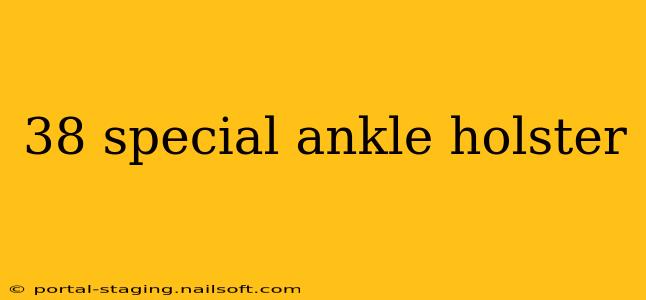Choosing the right ankle holster for your 38 Special revolver is crucial for comfort, safety, and effective concealed carry. This comprehensive guide will help you navigate the world of ankle holsters, focusing on finding the perfect fit for your firearm and your needs. We'll explore key features, considerations for different body types, and best practices for safe and responsible concealed carry.
Why Choose an Ankle Holster for a 38 Special?
Ankle holsters offer a discreet method of carrying a firearm, particularly beneficial for those seeking deep concealment. The 38 Special, a relatively compact and powerful revolver, is a popular choice for ankle carry, particularly for individuals who prioritize a smaller, less cumbersome firearm for self-defense. However, it's important to understand the advantages and disadvantages before opting for this carry method.
Advantages of Ankle Holsters:
- Discreet Concealment: Ankle holsters provide excellent concealment, particularly under longer pants or loose-fitting clothing.
- Accessibility (for some): Depending on your body type and the holster design, accessing your firearm can be relatively quick.
- Backup Weapon: Many individuals use ankle holsters for a backup firearm, offering an extra layer of security.
Disadvantages of Ankle Holsters:
- Limited Accessibility: Reaching down to your ankle can be slower than other carry methods.
- Comfort Concerns: Carrying a firearm on your ankle can be uncomfortable, especially for extended periods. Proper fit and a high-quality holster are essential.
- Potential for Injury: Improper use or an ill-fitting holster can lead to discomfort or injury.
- Limited Firearm Choices: Only smaller firearms, like the 38 Special, are typically suitable for ankle carry.
Key Features to Consider When Choosing a 38 Special Ankle Holster:
Selecting the right ankle holster requires careful consideration of several key features:
1. Material:
- Kydex: Durable, lightweight, and moisture-resistant, Kydex is a popular choice for its rigidity and ability to retain its shape.
- Leather: Offers a more comfortable, softer feel against the skin, but may require more break-in time. Less durable and less water-resistant than Kydex.
- Nylon: A less expensive option, but can be less durable and prone to wear and tear.
2. Retention:
A secure retention system is crucial for safety. Consider holsters with:
- Thumb Break: A strap that secures the firearm until released manually.
- Passive Retention: The holster design itself securely holds the firearm in place without additional straps.
3. Comfort and Fit:
- Padding: Look for holsters with padding to minimize discomfort against the skin.
- Adjustable Straps: Adjustable straps ensure a secure and comfortable fit for your individual leg size.
- Breathability: Some holsters are designed with breathable materials to help prevent sweat and chafing.
4. Accessibility:
- Ease of Draw: Practice drawing your firearm from the holster to ensure it's quick and efficient. Consider holsters with a readily accessible release mechanism.
Choosing the Right 38 Special Ankle Holster for Your Needs:
Your body type, lifestyle, and level of experience should all influence your choice. Consult with experienced firearms professionals or visit reputable gun stores for advice.
Safe and Responsible Concealed Carry:
Regardless of the holster you choose, always prioritize safe and responsible gun handling practices. Regular practice, proper training, and understanding relevant local laws are paramount.
This guide provides a foundation for choosing a 38 Special ankle holster. Remember, safety and comfort are paramount. Invest in a high-quality holster that fits your needs and always practice responsible gun ownership.
